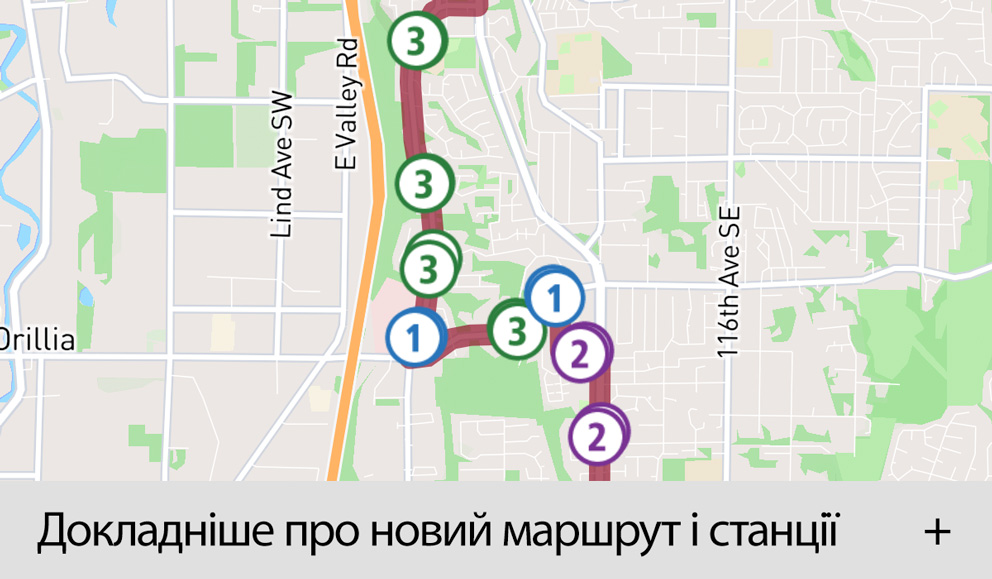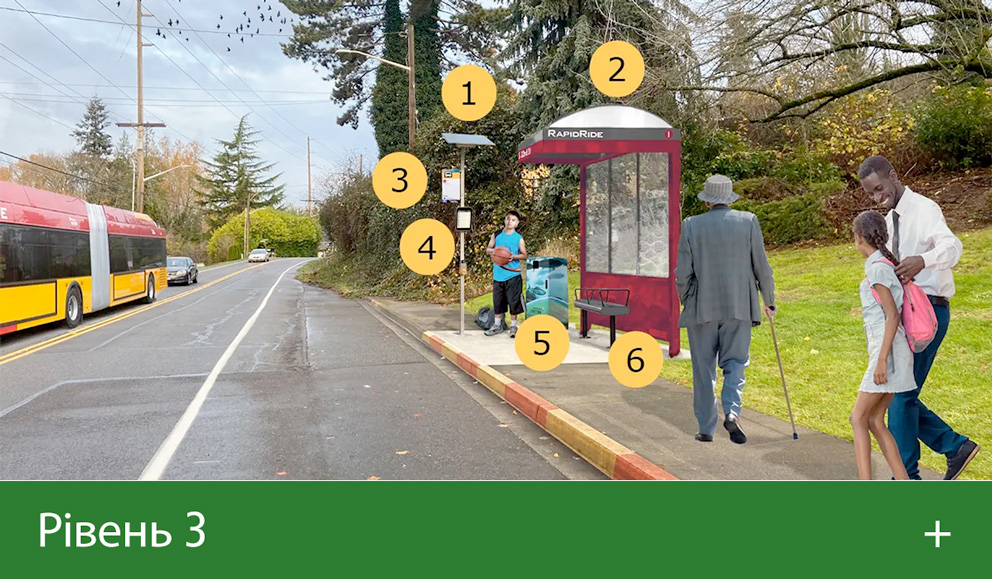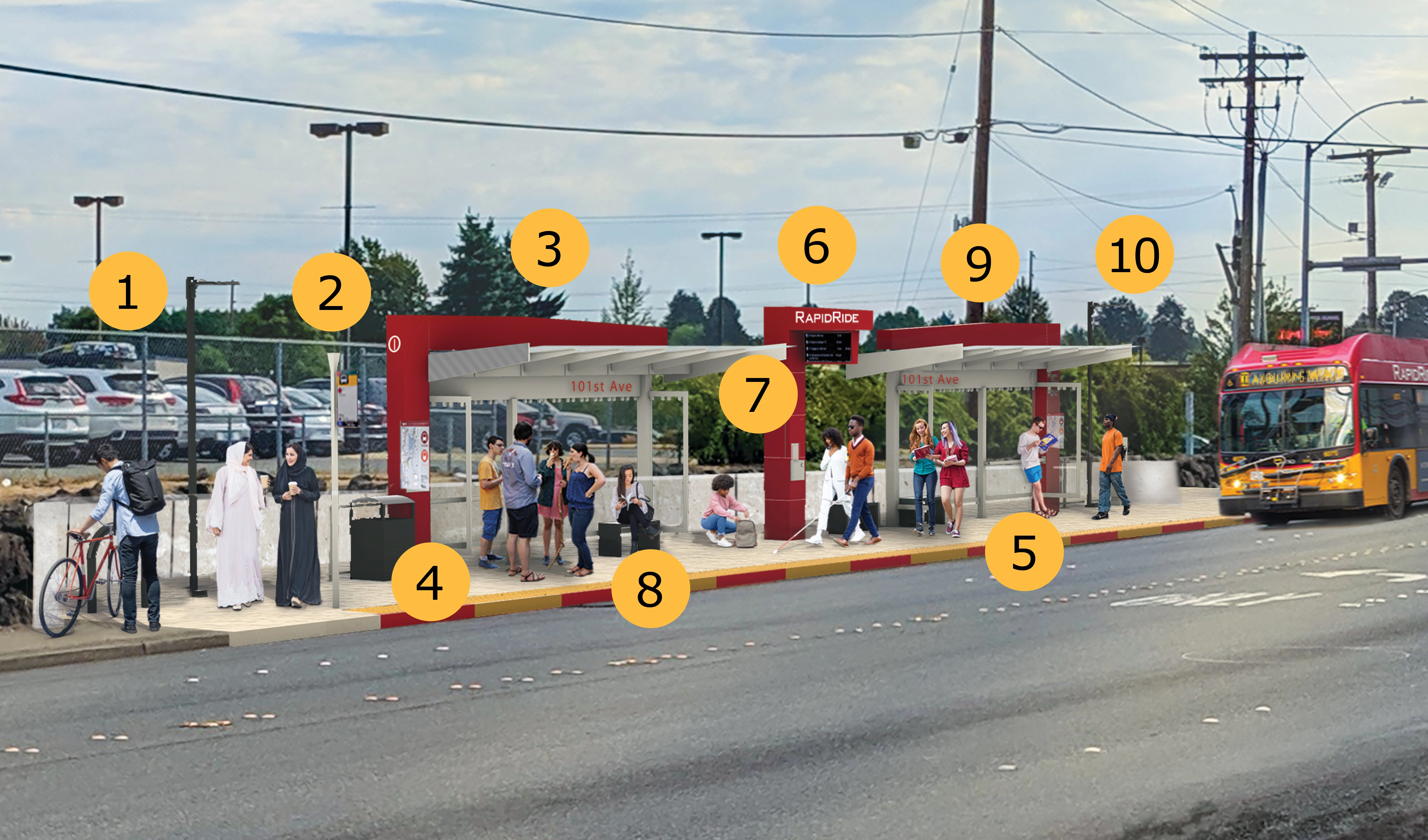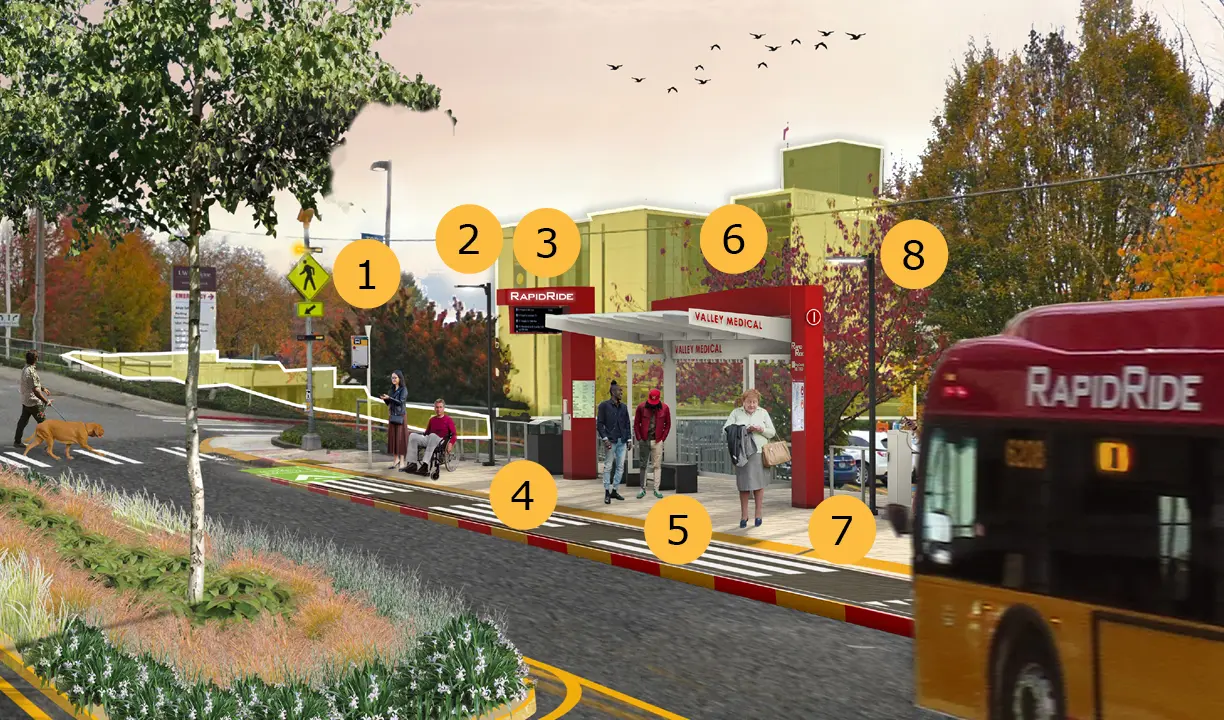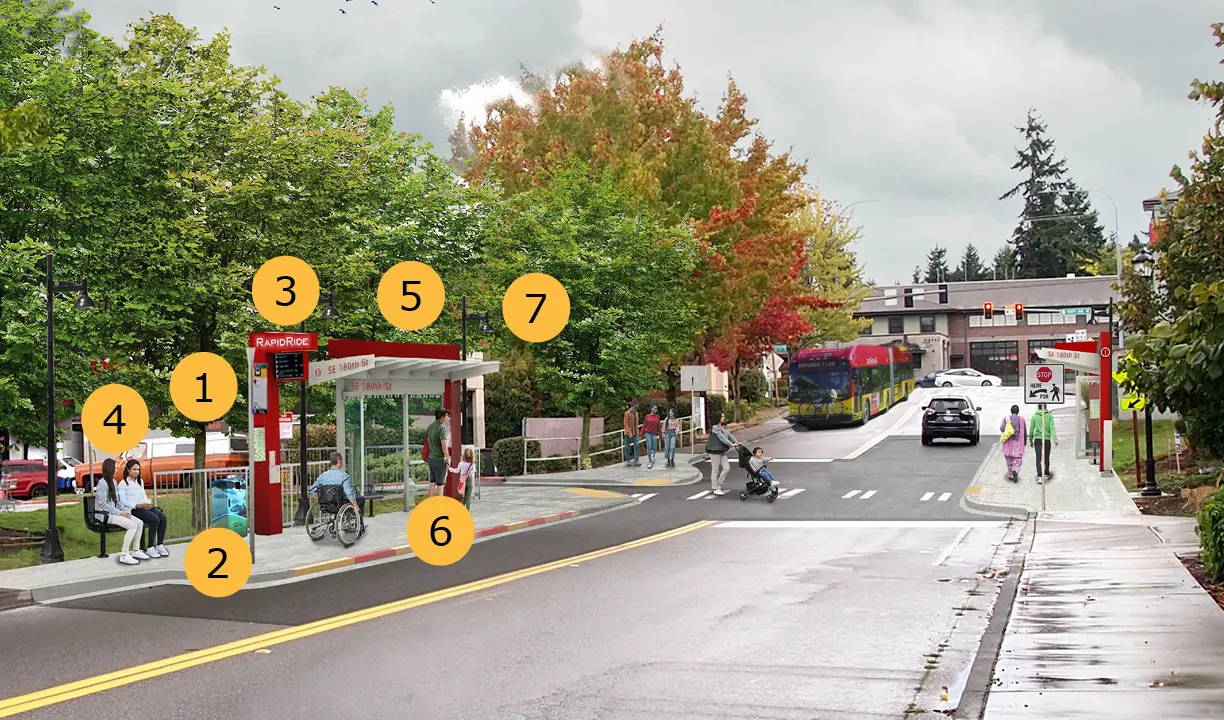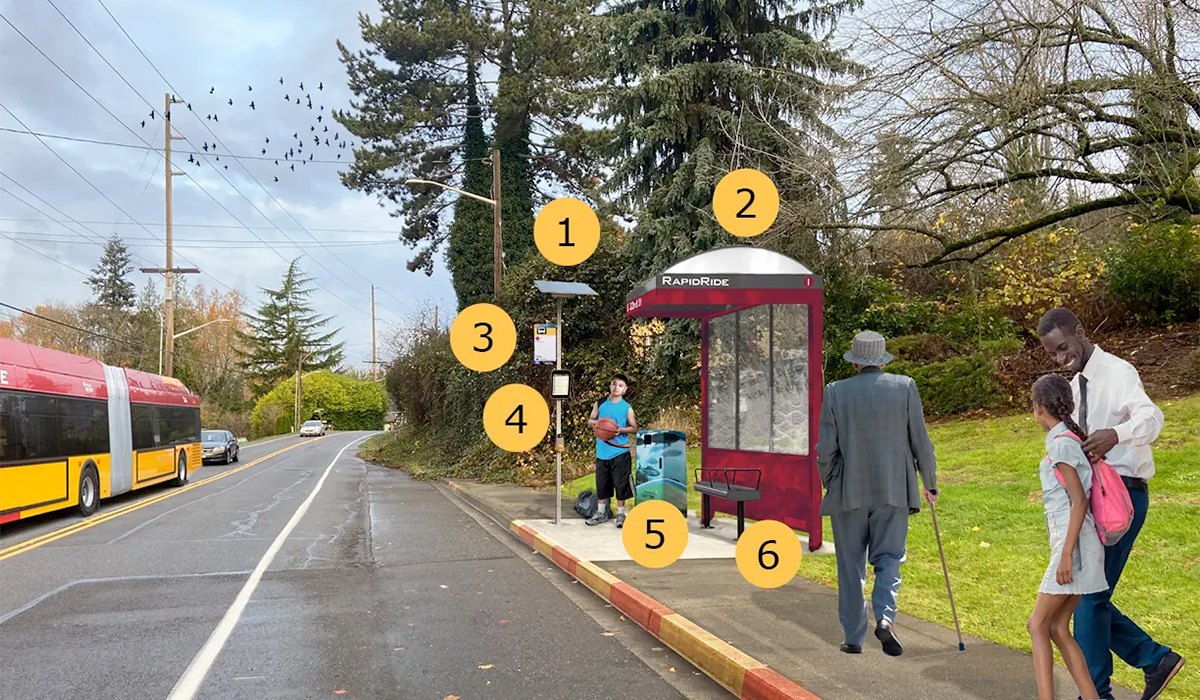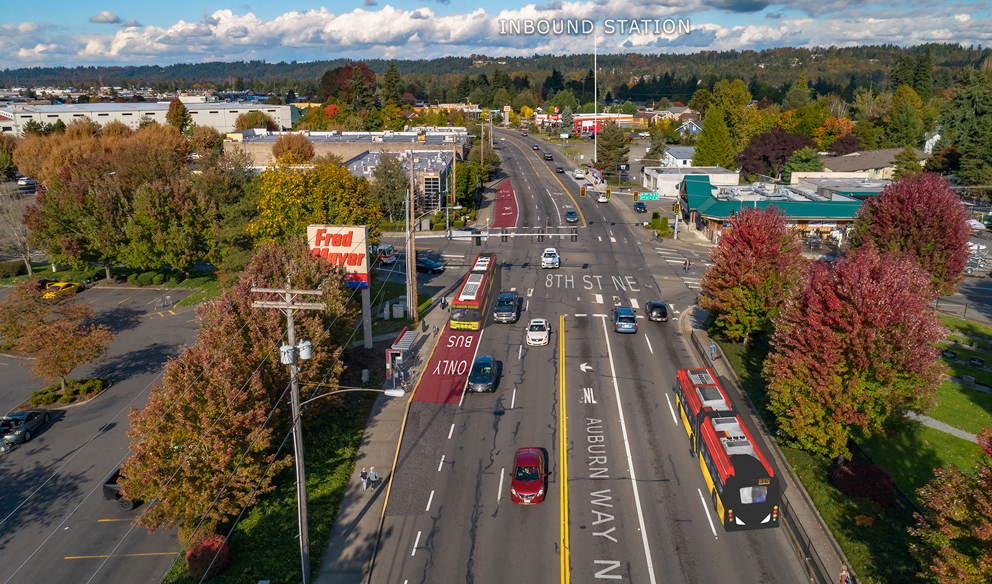RapidRide I Line
Поїздки в Renton, Kent i Auburn
Компанія Metro округу Кінг змінить маршрут 160 який зараз з’єднує Renton, Kent і Auburn. Він отримає назву лінія I RapidRide. RapidRide — це елемент великих системних поліпшень доступу до громадського транспорту на півдні округу Кінг. Запуск маршруту лінії I планується y 2027 році.
Автобуси, які підходять саме для вас. З ранку до вечора щодня.
Згідно з планом, автобуси лінії I RapidRide курсуватимуть кожні 10 хвилин у будні в години пік, кожні 15 хвилин у непікові години й кожні 30 хвилин увечері. У вихідні рейси відбуватимуться кожні 15 хвилин упродовж дня й кожні 30 хвилин рано-вранці й увечері.
Лінія I RapidRide: карта маршруту

Лінія I RapidRide запропонує швидке й надійне автобусне сполучення за маршрутом завдовжки 17 миль (27,4 км). Він з’єднає три вузли громадського транспорту (Центр громадського транспорту Renton, Центр громадського транспорту Kent та станцію Auburn), а також маршрут лінії F RapidRide, автобуси Sound Transit, поїзд Sounder і місцеве автобусне сполучення. Компанія Metro будує лінію I RapidRide для того, щоб задовольнити гостру потребу в удосконаленні транспортних можливостей у напрямку з півночі на південь на півдні округу Кінг. Усі роботи допоможуть пасажирам спростити поїздки в регіональні пункти призначення й назад, а також доступ до мережі місцевих автобусів. Натисніть або виберіть карту, щоб збільшити її та ознайомитися з новим маршрутом лінії I.
Покращення в межах автобусного маршруту
Пасажирські станції
82 станції RapidRide із новими функціями, призначеними підвищити безпеку та комфорт пасажирів.
Пріоритет сигналів та смуг руху громадського транспорту
Покращення на 27 перехрестях і розширення 12 смуг для доступу підприємств і громадського транспорту (BAT) для підвищення швидкості та надійності руху автобусів.
Поліпшення доступу й безпеки
64 нових або поліпшених пішохідних переходів й понад 100 нових пандусів, доступних для осіб з інвалідністю відповідно до Закону про американців з інвалідністю (Americans with Disabilities Act, ADA), для підвищення доступності та безпеки для пішоходів.
Сполучення з основними маршрутами громадського транспорту
Покращене сполучення з маршрутом лінії F RapidRide, поїздом Sounder в Auburn і Kent, автобусним сполученням Sound Transit (ST) та майбутнім швидким автобусним маршрутом ST у Renton (відкриття планується у 2028 році).
Участь спільноти
Як завдяки участі спільноти з’явилася лінія I
Громадський транспорт їде туди, куди вам потрібно, і тоді, коли вам потрібно
Маршрут, що з’єднує громадські об’єкти з великою кількістю рейсів у вечірній час і вихідні дні.
Більш швидке, надійне та регулярне автобусне сполучення
Капітальні поліпшення дадуть змогу автобусам ефективніше долати транспортний потік і частіше вирушати в дорогу.
Зручні й безпечні станції
Покращене освітлення, навіси й лавки на станціях.
Пересадки на інші види громадського транспорту
Маршрут, що з’єднує Sounder, Stride та інші лінії Metro.
Обслуговування насамперед слаборозвинених регіонів
Маршрути й місця розташування станцій визначено в співпраці зі слаборозвиненими регіонами та організаціями, які їх обслуговують.
Дістатися до автобусної станції стало простіше й безпечніше
Нові пішохідні переходи біля станцій, покращені тротуари, пандуси, світлофори для пішохідних переходів і спеціальні велосипедні доріжки.
Участь у проєкті місцевих художників
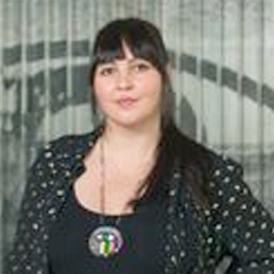
Ryan! Feddersen
Художницю Ryan! Feddersen обрали для створення серії художніх робіт на тротуарах і суміжних підпірних стінах.

Rey Daoed
Робота Rey Daoed є частиною обмеженого накладу карток ORCA, присвячених програмі розширення RapidRide.
Етапи проєкту
-
2019
Очікує на оцінювання
На першому етапі участі спільноти компанія Metro презентувала проєкт і зібрала відгуки щодо потреб і пріоритетів у сфері транспорту. Планування передбачало визначення маршруту й місця розташування станцій, а також ідеї щодо забезпечення більш легкого й безпечного доступу.
Завершений
-
2019
Розробка концепції
Початкова концепція
На другому етапі компанія Metro зібрала відгуки про передбачувані місця розташування станцій RapidRide, а також інші зауваження місцевих жителів. Ці думки допомогли Metro запланувати зміни швидкості та надійності, конструкції станції та доступу.
Завершений
-
2020
Розробка концепції
Бажана концепція
Компанія Metro представила бажану концепцію проєкту, включно з пропонованим маршрутом, розташуванням станцій, а також поліпшенням швидкості, надійності та доступності. Її було розроблено з використанням відгуків спільноти, отриманих під час початкової концепції та оцінки потреб. Надалі компанія Metro продовжила збирати відгуки для формування остаточної концепції проєкту.
Завершений
-
2021
Остаточна концепція готова на 30%
Компанія Metro використовувала відгуки місцевих мешканців для формування й коригування попередніх планів проєктування. У вересні 2020 року автобусні маршрути 169 і 180 було об’єднано в маршрут 160 (майбутня лінія I).
Завершений
-
2022
Остаточна концепція готова на 60%
Компанія Metro провела польові роботи та взаємодіяла з власниками нерухомості та підприємствами вздовж маршруту. Metro також зібрала відгуки про остаточну концепцію.
Завершений
-
2023
Остаточна концепція готова на 90%
омпанія Metro використовувала відгуки місцевих жителів для перегляду остаточної концепції. Компанія Metro також ділилась інформацією зі спільнотою на громадських заходах, щоб підвищити обізнаність про лінію I RapidRide, а також повідомляла про те, як відгуки спільноти вплинули на плани дизайну.
Завершений
-
2024
Остаточна концепція готова на 100%
Компанія Metro проаналізувала попередні відгуки населення та зосередилася на завершенні проєктування для того, щоб отримати дозволи на будівництво й завершити придбання нерухомості.
Завершений
-
2025-2027 pp.
Будівництво лінії I RapidRide
- Будівництво нових станцій та інші капітальні поліпшення, як-от тротуари й пандуси; поліпшення пішохідних переходів і велосипедних доріжок; розширення проїжджої частини, асфальтування та повторна розмітка; а також смуги для доступу підприємств і громадського транспорту (BAT), модернізація світлофорів та інші пріоритетні рішення для громадського транспорту
- Спорудження громадських артоб’єктів
- Участь спільноти в будівництві
Запуск і тестування
- Навчання операторів лінії I
- Тестування та введення в експлуатацію ІТ-систем (нові світлофори, покажчики з оновленнями в реальному часі, системи оплати за проїзд ORCA)
Поточний
-
2027
Запуск сполучення
Запуск лінії I RapidRide
Чого очікувати під час будівництва
Компанія Metro планує почати будівництво восени 2025 року. Робочий час на будмайданчику: з понеділка до п’ятниці із 7:00 до 15:30, а також можлива робота в нічний час і на вихідних.
Під час будівництва ви можете зіткнутися з такими незручностями:
- тимчасові обмеження для паркування автомобілів;
- періодичне закриття смуг і під’їзних колій та під’їзних шляхів;
- робота великогабаритної техніки й вантажних автомобілів;
- незручності з паркуванням поблизу деяких будівельних майданчиків;
- закриття деяких тротуарів, перехресть і смуг руху;
- об’їзди для пішоходів, велосипедистів і ролерів;
- тимчасові об’їзди автобусних маршрутів і перенесення автобусних зупинок на маршруті 160 та інших міських і міжміських маршрутах;
- регулювальники для регулювання руху транспорту навколо робочих зон.
Бібліотека ресурсів
Ресурси щодо роботи з громадськістю
- Короткий опис роботи з громадськістю (2022) - англійською
- Підсумковий звіт про роботу з громадськістю (2021) - англійською
- Звіт про роботу з громадськістю на етапі 3 (2020) - англійською
- Звіт про роботу з громадськістю на етапі 2 (2020) - англійською
- Звіт про роботу з громадськістю на етапі 1 (2020) - англійською
- Звіт про роботу з громадськістю на етапі 1-3 (2020) - англійською
Ресурси про розробку концепції
- Звіт про зміни концепції (2023)
- Звіт про зміни в плануванні транспортного коридору (2020)

 Translate
Translate
